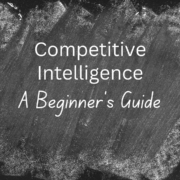Unlocking Competitive Insights: Beginner’s Guide
What Is Competitive Intelligence?
As the term implies, “competitive intelligence” is a set of practices that make your organization more competitive. What competitors are doing is one piece of this intelligence, but not the entirety. The perceptions and behavior of end customers are other important components of competitive intelligence. Since customers are ultimately what drives opportunities and revenue, understanding how your organization and competitors are perceived in the market is necessary to improve competitive positions.
Another facet of competitive intelligence is ecosystem intelligence, which includes partnerships. No business in any industry can operate in a silo, making partnerships an integral part of how value is conveyed to customers and the market.
Lastly, to truly be effective, competitive intelligence across competitors, customers and partners needs to be wrapped in the context of an organization’s current business situation. This final layer takes a collection of facts and observations and turns it into intelligence that can improve an organization’s competitive position, otherwise known as “competitive intelligence.”
Understanding Competitive Intelligence for Businesses
Importance of Competitive Intelligence for Businesses
Competitive intelligence can provide a number of benefits:
- Apples-to-apples comparisons: Operating a business on a day-to-day basis can provide a lot of insight and information on competitors, but oftentimes the volume of information can be more challenging to fully understand and put into a useful context. Competitive intelligence that uses a standardized set of criteria, often with financial performance as the comparative metric, gives more rigor and confidence when drawing conclusions about your business’s performance versus competitors’.
- Strategy development: Mimicking or copying competitors’ business practices is not always a good idea, but understanding what is taking place in the market can be a good way to generate some potential options your business should consider. An awareness of where competitors are investing and what forms those investments are taking can be a sound starting place for evaluating your own strategy.
- Investment validation: In a similar vein to the benefits of strategy development, understanding how much competitors are investing in certain areas and in which forms can provide support and validation when making investments. This intelligence does not guarantee success or failure but at least provides an external point of reference that confirms other businesses are behaving in a similar fashion.
Key Objectives of Competitive Intelligence
- Identify a key question or objective for the intelligence: Trying to learn everything about a competitor is not a realistic or feasible objective for intelligence. Breaking down the decisions your organization is trying to make so the intelligence can be targeted is the first step to make competitive intelligence valuable.
- Identify the right competitors: This will partially be based on the first step above, but it’s a good second step to ensure the intelligence aligns to the outcome. Based on the key premise, understanding which competitors are more valuable than others helps focus the intelligence and research. This is where data points collected during business operations can help guide the decision making: Are there things being heard by the sales team or in customer conversations that warrant a deeper understanding?
- Connect intelligence to the business operations and planning: Aligning to business strategies and outcomes is how competitive intelligence actually delivers value, so it’s best to have that coordinated early. Competitive intelligence should not be stored in a library but tied into ongoing business improvement and change.
The Process of Collecting and Analyzing Competitive Intelligence
Design and Standardization
Everything about operating in the information technology market is complex, including the offerings themselves, the web of partnerships and alliances involved in solution development and distribution, and finally the customer environments into which these solutions are deployed. For this reason, the boundaries, parameters and definitions of competitive intelligence are important to define upfront.
Research Methodology
After parameters and definitions for the study are defined, it’s important to next outline the methodology to be used for the research. Most times, a thorough secondary research effort provides a baseline for the intelligence. Nowadays, there is a wealth of sources available, including government financial filings, investor presentations, social media content and news outlets, that can provide quite a bit of competitive information.
Beyond those tactics, the broad realm of primary research can be used to dive deeper into specific questions. The target and method for that primary research vary quite a bit, however. If statistical feedback on customer behavior and perceptions is needed, then a survey is the best methodology. For more emerging topics, qualitative interviews can be the best medium. For more competitive studies, understanding key executives’ strategy and logic around taking certain approaches can be invaluable to connect the dots and provide actionable intelligence from the research.
Relevance for Your Business
For every competitive intelligence study, tying the key findings back to your own business is a critical step. No two companies are the same, so learning from competitors’ strategies and investments is helpful but not always directly applicable. To translate research into intelligence that is actionable, you need to take into account the nuances of your organization’s current state in the market, including strengths and weaknesses and existing perception among customers. No changes should be made without considering all the peripheral factors and existing stakeholders. The best way to make intelligence relevant is to include your own organization within the context of the study.
Implementing Competitive Intelligence in Your Business
A well-conducted competitive intelligence study is designed from the outset to be implemented into your business:
- Definitions and parameters are clear upfront to make sure the findings are relevant to your business, markets and customers.
- The methodology chosen is best suited to the types of intended actions and outcomes.
- All internal stakeholders have been informed and included throughout the process to avoid surprises and minimize resistance to new changes and strategies.
- The findings of the study have been framed within the context of your existing business.
Conclusion
When used effectively, competitive intelligence can be a powerful tool for your business. Operating in a competitive market, there can be a lot of uncertainty. Is your strategy aligned to what customers want? Are you overspending on certain initiatives? Are you missing potential opportunities to earn more revenue or reduce expenses?
For all of these fundamental questions, competitive intelligence can provide more certainty when making business decisions and ultimately increase your alignment to prevailing trends in the market. However, for competitive intelligence to deliver that benefit to organizations, the design and context of the intelligence are critical.
Narrowing in on key areas of research, with parameters and definitions clearly identified at the onset, is a best practice for getting started with competitive intelligence. On the back end, wrapping those pieces of intelligence in a final layer of context is the most effective way to realize the value from competitive intelligence efforts.
Stay ahead of the curve with our latest insights and updates. Subscribe to Insights Flight now to receive exclusive content, expert tips, Q&A invitations and industry analysis straight to your inbox. Don’t miss out on the opportunity to elevate your knowledge and stay informed!

 Technology Business Research, Inc.
Technology Business Research, Inc.
